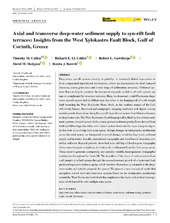| dc.contributor.author | Cullen, Timothy M | |
| dc.contributor.author | Collier, Richard E.L.I. | |
| dc.contributor.author | Gawthorpe, Rob | |
| dc.contributor.author | Hodgson, David M. | |
| dc.contributor.author | Barrett, Bonita J | |
| dc.date.accessioned | 2020-06-24T08:28:06Z | |
| dc.date.available | 2020-06-24T08:28:06Z | |
| dc.date.issued | 2019 | |
| dc.Published | Cullen TM, Collier RE, Gawthorpe R L, Hodgson DM, Barrett BJ. Axial and transverse deep‐water sediment supply to syn‐rift fault terraces: Insights from the West Xylokastro Fault Block, Gulf of Corinth, Greece. Basin Research. 2019 | eng |
| dc.identifier.issn | 1365-2117 | en_US |
| dc.identifier.issn | 0950-091X | en_US |
| dc.identifier.uri | https://hdl.handle.net/1956/22907 | |
| dc.description.abstract | Deep‐water syn‐rift systems develop in partially‐ or transiently‐linked depocentres to form complicated depositional architectures, which are characterised by short transport distances, coarse grain sizes and a wide range of sedimentary processes. Exhumed systems that can help to constrain the tectono‐stratigraphic evolution of such systems are rare or complicated by inversion tectonics. Here, we document a mid‐Pleistocene deep‐water syn‐rift system fed by Gilbert‐type fan deltas in the hangingwall of a rift margin fault bounding the West Xylokastro Horst block, on the southern margin of the Gulf of Corinth, Greece. Structural and stratigraphic mapping combined with digital outcrop models permit observations along this syn‐rift depositional system from hinterland source to deep‐water sink. The West Xylokastro Fault hangingwall is filled by two distinct sediment systems; an axial system fed by coarse‐grained sediment gravity flows derived from fault‐tip Gilbert‐type fan deltas and a lateral system dominated by mass transport deposits fed from an evolving fault‐scarp apron. Abrupt changes in stratigraphic architecture across the axial system are interpreted to record changes in relative base level, sediment supply and tectonics. Locally, depositional topography and intra‐basinal structures controlled sediment dispersal patterns, from bed‐scale infilling of local rugose topography above mass transport complexes, to basin‐scale confinement from the fault scarp apron. These acted to generate a temporally and spatially variable, heterogeneous stratigraphic architecture throughout the basin‐fill. The transition of the locus of sedimentation from a rift margin to a fault terrace through the syn‐sedimentary growth of a basinward fault produced regressive surfaces updip, which manifest themselves as channels in the deep‐water realm and acted to prograde the system. We present a new conceptual model that recognises coeval axial and transverse systems based on the stratigraphic architecture around the West Xylokastro fault block that emphasizes the lateral and vertical heterogeneity of rift basin‐fills with multiple entry points. | en_US |
| dc.language.iso | eng | eng |
| dc.publisher | Wiley | en_US |
| dc.rights | Attribution CC BY | eng |
| dc.rights.uri | http://creativecommons.org/licenses/by/4.0 | eng |
| dc.title | Axial and transverse deep‐water sediment supply to syn‐rift fault terraces: Insights from the West Xylokastro Fault Block, Gulf of Corinth, Greece | en_US |
| dc.type | Peer reviewed | |
| dc.type | Journal article | |
| dc.date.updated | 2020-01-04T12:28:06Z | |
| dc.description.version | publishedVersion | en_US |
| dc.rights.holder | Copyright 2019 The Author(s) | en_US |
| dc.identifier.doi | https://doi.org/10.1111/bre.12416 | |
| dc.identifier.cristin | 1760251 | |
| dc.source.journal | Basin Research | |

